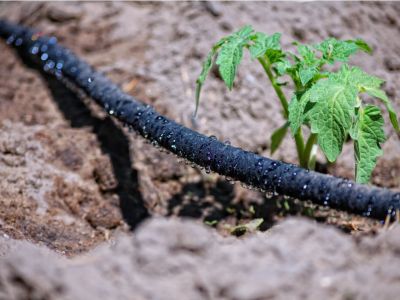Residential Irrigation System Examples
The different irrigation types can be divided into two broad categories: Those which send water droplets into the air and those which deliver at ground level. Within each category, an irrigation system design can be simple or complex, manual or automatic and can be quite affordable or more costly. Here are several basic irrigation system examples: Above-Ground Sprinklers – Perhaps the least expensive and easiest to set-up, these sprinklers are the type you attach to the end of a hose and drag to the area you wish to water. They are versatile and can effectively water lawns, groundcover or a densely planted garden area. Above-ground sprinklers are best suited for climates which only experience periodic dry spells. Con: Water wastage is the major drawback to those types of irrigation systems which deliver airborne water. These systems lose efficiency due to evaporation and droplets landing on hard surfaces. In-Ground Sprinklers – This irrigation system designed for delivering airborne water relies on underground pipes and may require professional installation. Most of these systems are totally automated and can be programmed to water where, when and how much the homeowner desires. An automated in-ground sprinkler system may be a good choice for watering lawns in drought-prone regions. Con: In addition to water wastage, in-ground sprinkler systems can be fairly expensive to install and repair. They also require routine maintenance, particularly in climates where winter temps drop below freezing. Drip – With this irrigation system design, solid hose or underground pipe is connected to a series of emitters which deliver a slow trickle of water to precise locations at the base of plants. This can be a healthier method of water delivery, as it doesn’t wet the foliage or splash soil-borne pathogens onto the plant. Of the different irrigation types, drip systems are the most water conservative. Cons: Like in-ground sprinklers, drip irrigation is more costly to install. These systems do require maintenance. A clean water supply is also essential to avoid clogging the emitters. Soaker Hose – Another one of the ground-delivery types of irrigation, soaker hoses are both versatile and economical. These perforated sections of flexible hose can be place on top of the ground or buried under the mulch. Soaker hoses can be used temporarily in the vegetable garden or around a newly planted tree. In water-regulated municipalities, the perforated hose can also be cut into sections and connected with standard garden hose to deliver a more precise watering solution. Cons: A soaker hose seeps water along its entire length, including the spaces between plants. This can encourage weeds and wastes water. Creating a more permanent, water-conserving irrigation system using sections of perforated hose alternated with solid hose can solve these problems, but it’s time-consuming and costly to set up. Soaker hoses also tend to lose pressure near the end of the run and they often distribute water unevenly on slopes.
